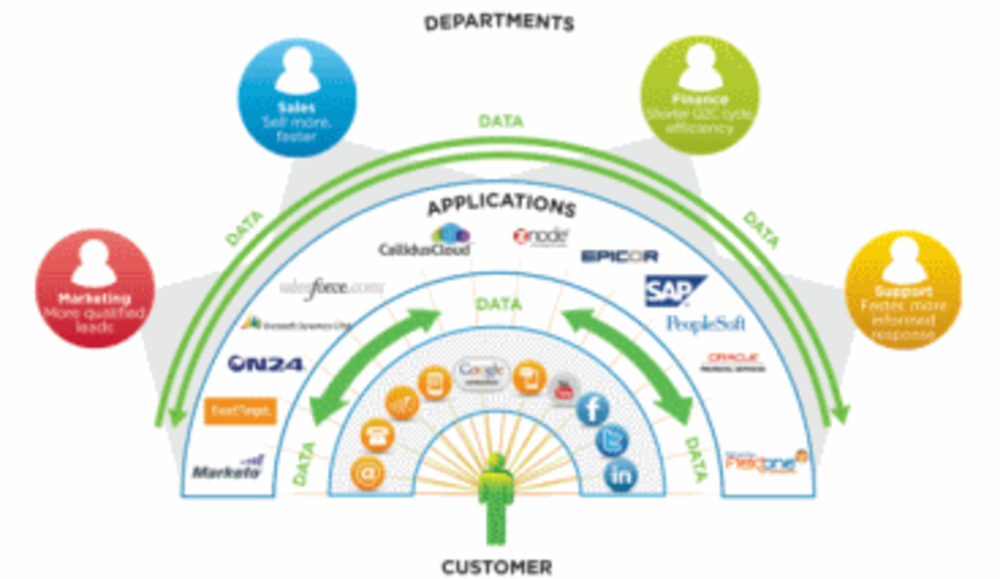As marketing executives increasingly rely on IT to manage today’s rapidly changing customer environment, getting a 360-degree view of cross-channel customer data to make the right decisions and accelerate business growth has become essential. Marketers are charged no more than ever with tapping data to inform successful marketing strategies. Add complex integration challenges to the mix as marketing automation tools become the norm, and the need to simplify integration between customer-facing systems becomes painfully clear. With marketers now owning more of the IT budget than ever before, it is critical they firmly take the reins and own customer data to increase effectiveness and drive business value.
Rather than wasting valuable time tracking down and cobbling together data, organizations need to refocus their efforts on selling, marketing, and improving customer satisfaction if they want to remain competitive. True marketing leaders are the ones who choose to embrace their elevated IT relationship by breaking down silos through fostering customer data access and integration across departments and channels.
To speed data integration, improve marketing successes, and keep customer data ownership firmly in marketers’ hands, marketers must prioritize integration by following five basic steps.
1. Look at integration as a continuous cycle.
Integration is no longer about simply connecting two systems. With so many customer touchpoints feeding a variety of disparate applications (some in the cloud and some on premise), data needs to easily and instantly flow across numerous platforms and departments. Establishing a platform that fosters continuous integration helps marketers rationalize and organize the excessive amount of customer data collected and better leverage it across all of the marketing channels to drive higher revenue and improve customer satisfaction—all at a lower cost.
2. Redefine (and broaden) your definition of integrated marketing.
It can’t be too basic. For example, while most enterprise-class marketing automation platforms provide some level of integration, an effective integrated marketing campaign requires marketers to not only tap the powerful features of the marketing platform, but they also need to fully leverage data within existing CRM systems and other business applications. Further, integrating all of a company’s data and processes across every application (at every level) to try to create a fully unified customer record would also be a waste of time and potentially hamper application effectiveness.
3. Prioritize strategic business outcomes.
To start, determine how to best capture data from across other systems, including CRM, customer support, and ERP. This will drive more targeted and personalized outbound and inbound communication with customers. Then, once a customer or prospect has been identified, document how to ensure he is immediately directed to the right channels for follow up—on a consistent basis. Finally, figure out how to gain a complete understanding of the marketing/sales funnel to increase visibility into the success or failure of marketing initiatives so investments and tactics can be adjusted accordingly.
4. Dive into the details.
Define discreet use cases (who, what, when) and logical data mapping. Start with the use cases that support your marketing objectives and directly state requirements in clear language. Once that’s complete, determine the logical data maps that will drive the integration itself and build any prerequisites (e.g., data synchronization that needs to happen at a certain step in the process) into the design.
5. Start small.
Achieving integrated marketing success is a long-term journey. The key is to tackle the problem in manageable increments. Prioritize the integration use cases by their business value/return versus the cost and complexity to implement. Start with high-value, low-effort initiatives to build experience/momentum before managing more complex, high-value use cases. It is critical to implement and iterate quickly, which is best achieved by tapping a flexible and easy-to-use platform to create and manage your integration efforts.
Any company can collect reams of data—that’s the easy part. What separates the winners from the losers is the ability (or lack thereof) to connect different types of customer data across multiple channels. As marketers are increasingly given ownership of customer information, they can no longer afford to ignore the gap between desire and achievement when it comes to customer data integration. Marketers who make integration a priority today will not only benefit from a greater yield on marketing spend but will also have the foundation in place to be more strategic, enabling them to stay ahead of the competition tomorrow.
Peter Chase is the founder and VP of business development at Scribe Software.







